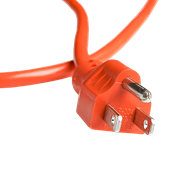
Electricity is magical – it can bring light to dark places, power music and movies, and generally makes the world go round. However, electricity is very powerful and with great power, comes a great need for safety. At OPPD, we are committed to keeping employees, customer-owners, and the community safe. Electrical safety can, and should, be followed at all times. No matter what you’re doing, OPPD wants you to remain safe both inside and outside of your home.
Don’t be Shocked by In-Home Safety Risks
When we’re spending time at home, we like to have things plugged in, connected, and online. But if we’re not paying attention to how we’re using our devices, we can face safety risks like electrocution or fire.
According to the National Fire Protection Association, over 47,000 home fires in the U.S. are caused by electrical failure or malfunction. Overloaded electrical circuits are one of the biggest causes of residential fires.
Warning signs of an overloaded circuit include:
- Flickering or dimming lights
- Frequently tripped circuit breakers or blown fuses
- Receiving a mild shock or tingle from appliances or switches
- Your wall outlets can also be a good indicator of an overloaded circuit. Be aware of any warm or discolored wall plates around the outlet, as well as burning odors or crackling and buzzing sounds from the outlet.
There are several preventative steps you can take to keep your home and family as safe as possible.
- Ensure major appliances are plugged directly into a wall outlet.
- Don’t overload your wall outlet or power strip. One outlet should not exceed 1,500 watts in devices.
Remember: power strips and outlet extenders do not increase electrical capacity. - Make sure power cords aren’t frayed, damaged, or placed under rugs or carpet.
- Keep all electric appliances away from water and consider installing ground fault circuit interrupters on outlets near water (in your bathroom, kitchen, or laundry room).
- Use the correct wattage bulb in your lamps. If you don’t know the correct wattage, use a bulb that is 60 watts or less.
- Consider buying power strips with an over-current protector. They will cut off power to the strip automatically if too much current is being drawn.
- If you rely heavily on extension cords and power strips in your house, hire a qualified electrician to inspect your home and discuss potential capacity solutions.

 Learn More!
Learn More!
Electric Safety Tips
Electrical Safety for Dorm Life
5 tips for Electrical Safety in Your Home
What’s a Ground Fault Circuit Interrupter?
Electrical Safety Foundation International (ESFI)
Occupational Safety and Health Administration (OSHA) Electrical Guidelines
Above or Below – Be Aware of Where the Power Lines Go
Electrical safety also needs to be observed while you work or play outside of your home. Many outdoor activities can run the risk of coming into contact with power lines including kite flying, trimming trees, or using ladders to access roofs. When you are outside, be aware of where the overhead power lines are located. If you are participating in an activity where an object or equipment may come close to the height of the overhead power lines, make sure you’re a safe distance away. The Occupational Safety and Health Administration (OSHA) has distance guidelines that vary based on the voltage of the line. When in doubt, always stay at least 20 feet away to ensure your safety.
You also need to be aware of the power lines that go into your house and be careful to avoid them. If you’re working on a roof, place ladders or scaffolding 10 to 20 feet away, even if your ladder is not made of metal. If you are moving a large object, identify a safe route that avoids power lines. You may also call OPPD (402-536-4131) in advance to discuss the possibility of de-energizing the power line before beginning the work.
Occasionally, overhead power lines come down. Several things can cause this to happen including high winds, heavy snow and ice, or a vehicle crash at a power pole. If you see a downed power line, immediately call 911 or OPPD at 1-800-554-6773. Always assume downed lines have electricity running to them and stay at least 50 feet away. Keep others (neighbors and pets) away from the line, and do not drive over it. Make sure you don’t touch anything that is in contact with the line.
Do you live or work in an area that doesn’t have overhead power lines? You still need to be aware of power line safety. If you are planning to complete any work that requires digging into the ground near your home, business, etc., state law requires you call to have any underground utility lines located and marked. Call 881 before you dig or visit the Nebraska811 website for more information.
Check out the links under Learn More! to get additional tips on electrical safety and empower yourself to stay safe.

